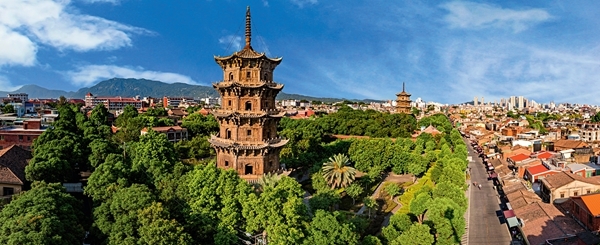Quanzhou, where the Maritime Silk Road starts
 0 Comment(s)
0 Comment(s) Print
Print E-mail China Today, September 12, 2017
E-mail China Today, September 12, 2017
Located in southeast Fujian Province, the coastal city Quanzhou is dotted with rolling hills, valleys, and basins; the Daiyun Mountain extends southwest from the northeast of the city. Throughout its long history, Quanzhou has seen the birth of southern Fujianese culture, and it was one of the first Chinese trade ports opened to the outside world. With scores of scenic spots and historical sites, Quanzhou has been affirmed by UNESCO as the starting point of the Maritime Silk Road.
A Culture with Far-reaching Influence
Southern Fujianese culture is also called Minnan culture (in Chinese, Min is the shortened name for Fujian, and nan means south). It originated in Quanzhou and has been cultivated together with the people of southern Fujian. With the Minnan dialect as its carrier and maritime culture at its core, Minnan culture constitutes an important part of the greater Chinese culture; its sphere of influence reaching Fujian, Zhejiang, Guangdong and Taiwan, and even as far as Singapore and other Southeast Asian countries.
|
Two ancient stone towers in the Kaiyuan Temple of Quanzhou City. Chen Yingjie |
In the Han (206 BC-AD 220) and Jin (265-420) dynasties, large numbers of ethnic Han people from the central plains of China migrated south to Quanzhou. Hence the culture of the central plains began to merge with that of southern Fujian, thus precipitating the formation of Minnan culture.
Quanzhou saw a significant population increase and economic development during the Song (960-1279) and Yuan (1206-1368) dynasties, and the city thus became the starting point of the Maritime Silk Road and an important port in the East. As Arabs and Persians arrived in Quanzhou for trade, they enriched the Minnan culture with their own Islamic traditions.
During the Ming (1368-1644) and Qing (1616-1911) dynasties, European businessmen and missionaries brought Western culture to Quanzhou, further boosting local cultural development. After thousands of years of encounters and integration with various peoples, a diversified cultural system fusing agricultural civilization, maritime trade, and religious culture took shape.
|
An aerial view of Quanzhou. Chen Yingjie |
Minnan dialect, one of China’s eight major dialects, originated in Quanzhou, but its popularity has gone far beyond its geographical homeland. In Taiwan, apart from that in the Gaoshan ethnic group settlements, Minnan dialect can be heard almost everywhere. In Singapore, 70-80 percent of the local population can speak or understand it. More than 40 million people across the world are proficient in it.
Architecture is an important proponent and embodiment of a culture. In Quanzhou, the most typical of traditional architectural styles is the ancient cuo (meaning “house” in the local language). These ostentatious and magnificent ancient cuos feature red bricks and tiles, white stone bases, roofs that are sunken in the middle and tipped with raised, fork-tailed ridges at either end, and embellished with exquisite stone and wood carvings. The larger residences, fashioned in the traditional style in modern and contemporary times, have mostly been built by eminent figures, as well as overseas Chinese and business tycoons to house several generations of their family.
Another of Quanzhou’s distinctive local architectural styles is the oyster shell house, whose walls are inlaid with oyster shells. The greyish white shells contrast beautifully with the mottled granite and red bricks. Together they create a stunning sight to behold. These oyster shell houses are mainly distributed throughout the Xunpu, Fashi, Dongmei, and Jinqi neighborhoods, in Fengze District of Quanzhou City with Xunpu having the densest cluster of oyster shell houses.
“Fanzai” is a term used by Quanzhou people for the buildings that combine foreign and traditional Chinese architectural elements, mostly built during the Republic of China (1912-1949) period by overseas Chinese who returned from Southeast Asia. Fanzai buildings were mostly built with construction materials imported from Southeast Asia. Absorbing the merits of both traditional Minnan residential buildings and Southeast Asian architectural styles, these Fanzai buildings feature distinct designs, exquisite pieces of art work, marvelous carvings, colorful paintings, brick patterns, and sculptures.







